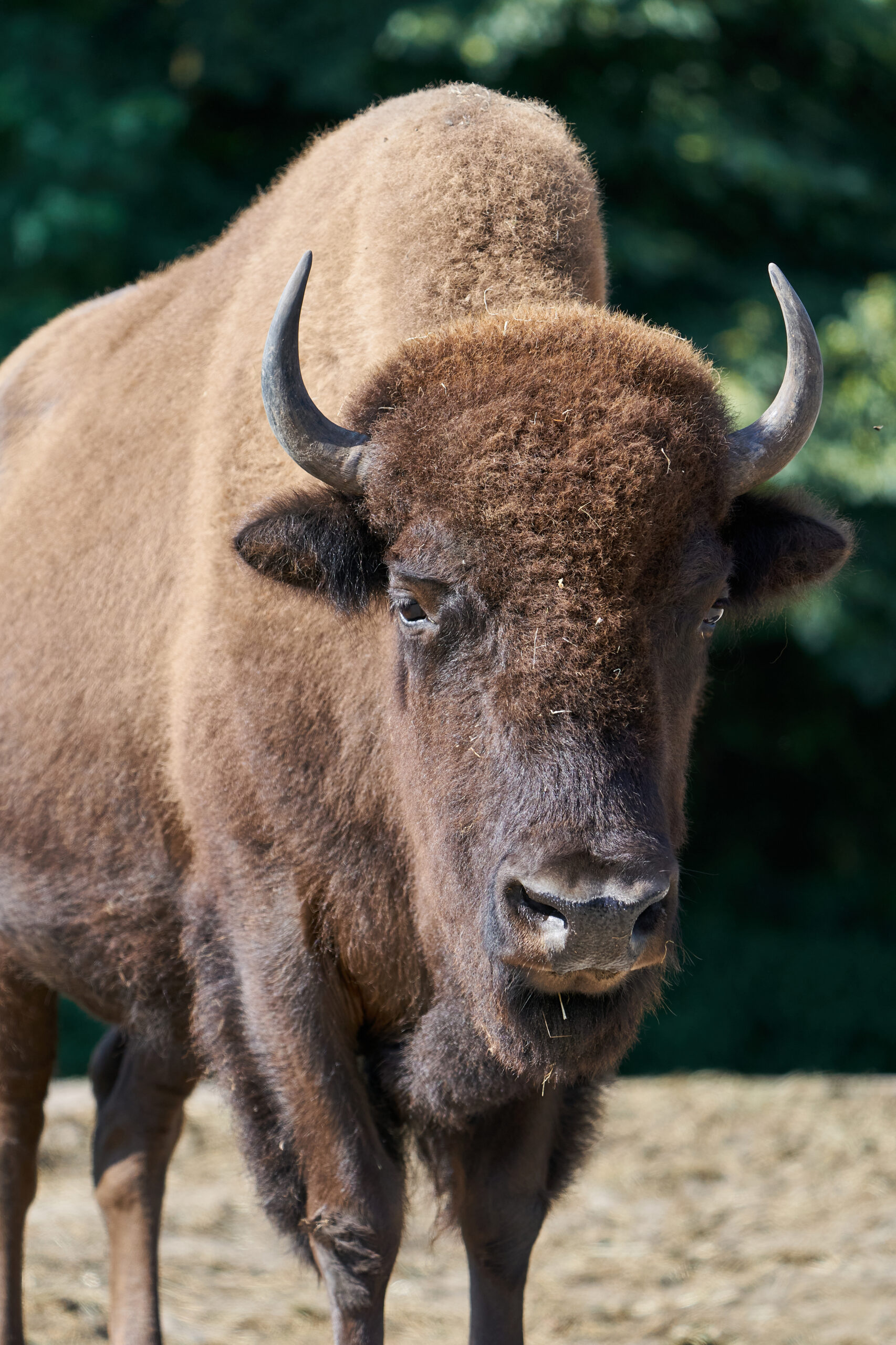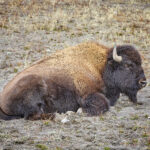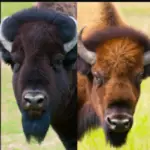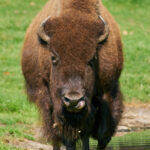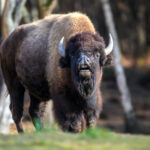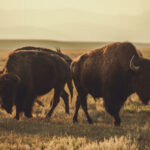When we think of bison, the image that often comes to mind is of a massive, shaggy creature leisurely grazing the grasslands or thundering in herds across the North American plains. Their sheer size and weight might lead many to underestimate their agility.
However, these behemoths of the animal kingdom harbor a surprising secret: they can jump. And not just a little hop.
A bison, despite its impressive bulk, can launch itself up to 6 feet vertically and leap 7 feet horizontally.
Let us explore the astonishing jumping abilities of the bison and delve deeper into how and why these creatures have evolved to possess such athletic prowess. Join us on this high-flying journey into the world of the bison.
Understanding Bison’s physical capabilities
Bison, also known as American buffalo, are magnificent creatures that possess impressive physical capabilities. This article aims to delve into their fascinating world, exploring their inherent attributes, anatomy, adaptation, and behaviors that contribute to their ability to jump. By understanding these aspects, we can gain insight into the factors that limit their jumping height and debunk common misconceptions surrounding their jumping abilities.
Examining bison’s inherent physical attributes
Bison are robust animals that have evolved to thrive in a variety of environments. They possess a sturdy build, with a humped shoulder characteristic of their species. This physical attribute grants them significant power and stability, enabling them to navigate various terrains and perform impressive jumps when needed.
One of the notable features of bison is their massive head and neck, which are designed to support their formidable horns. These horns, both in males and females, play a role in their jumping abilities. They provide balance and stability during a jump, allowing them to make quick, precise movements mid-air.
Comparison of bison’s physical strength with other similar-sized animals
When considering the physical strength of bison, it is essential to compare them with other animals of similar size. Bison can reach a weight of up to 2,000 pounds, making them one of the largest land mammals in North America. Despite their significant size, they possess an impressive agility and strength that few animals can match.
When compared to other large herbivores, such as moose or elk, bison’s physical prowess becomes evident. Their powerful muscles, honed by evolution and an active lifestyle, allow them to execute swift movements and generate considerable force when jumping.
The limit of bison’s physical abilities
While bison’s physical capabilities are indeed remarkable, they do have limitations. Due to their massive size, bison may face challenges when it comes to achieving exceptional jumping heights. Their own body weight acts as a deterrent to attaining great vertical leaps.
Moreover, their body structure, though advantageous in various aspects, may hinder them in achieving remarkable jumping heights. The hump on their shoulders, while providing strength and stability, can limit their upward mobility during a jump.
Exploring the Anatomy of Bison
To comprehend the intricacies of bison’s jumping capabilities, an analysis of their anatomy is paramount. By dissecting their structure, legs, and muscle mass, we can gain insights into the biomechanics of their jumps.
Analyzing the structure of bison’s legs
Bison possess sturdy legs equipped with strong bones and powerful muscles, essential for their locomotion and jumping. Their hind legs provide the primary driving force during jumps, propelling their massive bodies off the ground.
An interesting anatomical feature of bison’s legs is their adaptation for endurance and stability. Their lower leg bones are relatively short compared to other animals, allowing for greater strength and stability during jumps.
The role of bison’s muscle mass in jumping
Muscle mass plays a crucial role in a bison’s ability to jump. Their well-developed muscles, particularly in the hindquarters, provide the necessary strength and power for a successful jump. These muscles contract forcefully, allowing the bison to generate the required upward thrust to overcome gravity.
Furthermore, the muscles of the shoulders and neck work in harmony, providing stability and balance during a jump. This coordination between different muscle groups ensures a seamless and controlled execution of jumps.
Understanding the biomechanics of a bison’s jump
Biomechanics, the study of the mechanics of living organisms, helps us understand the intricate movements of bison during a jump. As the bison prepares to jump, it arches its powerful hindquarters, storing potential energy. In a matter of seconds, this energy is explosively released, propelling the bison upwards.
The bison simultaneously pushes off the ground with its hind legs while utilizing the strength of its neck muscles to maintain balance. By understanding the biomechanics of a bison’s jump, we can appreciate the complexity and grace of their movements.
Adaptation and Evolution of Bison
Bison’s jumping abilities are a result of their remarkable adaptation and evolution over thousands of years. Examining their historical evolution and the impact of adaptation on their jumping ability can provide valuable insights.
Study of bison’s historical evolution
Through extensive research and analysis of fossil records, scientists have gained valuable insights into the evolution of bison. It is believed that bison evolved from ancestors that roamed North America over two million years ago. Over time, they adapted to their environment, evolving specific physical attributes that contributed to their jumping abilities.
By studying the historical evolution of bison, scientists can understand the genetic changes that have occurred, leading to their current physical capabilities.
How adaptation may affect bison’s jumping ability
Adaptation plays a vital role in shaping an animal’s physical attributes and capabilities. For bison, their ability to jump has likely been influenced by adaptations that allowed them to survive in their natural habitat. The strength and agility required for jumping have likely evolved as a result of the challenges they faced, such as navigating difficult terrain or escaping predators.
The process of adaptation, occurring over generations, has fine-tuned bison’s physical attributes to suit their environment, including their jumping abilities.
Comparing ancient bison with modern-day bison
Comparing ancient bison with their modern-day counterparts allows scientists to gain insights into the changes that have occurred over time. Ancient bison, such as the extinct species Bison antiquus, had different physical characteristics that likely affected their jumping abilities.
Studying the differences between ancient bison and their modern-day counterparts can shed light on the impact of adaptation and environmental influences on their jumping abilities.
The influence of the natural habitat on Bison’s jump
The natural habitat of bison plays a significant role in shaping their jumping abilities. Factors such as the environment, terrain, and climate contribute to their capacity to jump.
The role of the environment in bison’s jumping ability
Bison inhabit a wide range of environments, including grasslands, plains, and forests. These diverse surroundings pose unique challenges that affect their jumping abilities. In open grasslands, for example, bison may have more opportunities to execute higher jumps due to unobstructed space and greater visibility.
Conversely, in forested areas with dense vegetation, bison’s jumping abilities may be limited by obstacles such as trees and undergrowth. The environment, therefore, plays a key role in shaping the extent of a bison’s jumping capabilities.
How terrain can affect a bison’s capacity to jump
The terrain on which bison roam can greatly influence their capacity to jump. Different terrains, such as rocky mountains, marshlands, or flat plains, present various challenges that impact their jumping abilities.
In rocky terrain, for instance, bison may need to navigate uneven surfaces and height variations, limiting their ability to achieve high jumps. On the other hand, in flat plains or marshlands, bison may have more freedom to execute powerful jumps due to the absence of significant obstacles.
Considerations of climate on bison’s activity levels
Climate, too, plays a role in determining a bison’s jumping ability. Extreme weather conditions, such as excessive heat or cold, can impact their overall activity levels, including their inclination to jump.
During periods of extreme temperatures, bison may conserve energy and limit their jumping activities to reduce the risk of exhaustion or dehydration. Their behavior and physical activities are intricately tied to climate, shaping the extent of their jumping abilities.
Bison’s behaviors and instincts that lead to jumping
Understanding the behaviors and instincts of bison provides valuable insights into the reasons why they jump and how it contributes to their survival.
Examining common reasons why bison jump
Bison exhibit jumping behavior for various reasons, often driven by their instincts and the need to navigate their surroundings. One of the main reasons bison jump is to cross obstacles such as rivers or fences. Their ability to execute powerful jumps allows them to overcome barriers that would otherwise impede their movement.
They may also jump when startled or threatened. When faced with a perceived danger, bison can exhibit impressive agility and leap over obstacles or escape predators by utilizing their jumping abilities.
Exploring bison’s hunting and fleeing techniques
Bison are herbivores and do not engage in active hunting. However, they have evolved remarkable fleeing techniques to avoid predators. When threatened, bison often resort to swift movements and jumps to create distance between themselves and their attackers.
These fleeing techniques, including jumping, are crucial for their survival and serve as a defense mechanism. Their ability to execute precise jumps allows them to navigate challenging terrain and evade predators effectively.
Behavioral aspects affecting a bison’s propensity to jump
Various behavioral aspects influence a bison’s propensity to jump. Factors such as age, health condition, and individual temperament can impact their willingness and ability to execute jumps.
Youthful bison may be more prone to engaging in playful jumping behaviors, honing their jumping skills and preparing for adult life. Additionally, bison in peak physical condition are more likely to showcase impressive jumps due to their enhanced strength and agility. However, older or physically compromised bison may exhibit limitations in their jumping abilities, emphasizing the influence of health on their jumping potential.
Scientific studies on Bison’s jumping ability
Scientists and researchers have dedicated considerable effort to studying bison’s jumping abilities, providing valuable insights into the scope and mechanics of their jumps.
Reviewing existing research on bison’s jumping
Several scientific studies have aimed to explore different aspects of bison’s jumping abilities. These studies utilize various methodologies, including direct observation in the field, controlled experiments, and advanced technologies to measure the height and extent of bison’s jumps.
By reviewing existing research, we can gain a comprehensive understanding of the scientific community’s findings and build upon their knowledge.
Understanding methodology and findings of past studies
Past studies have employed innovative approaches to measure and quantify bison’s jump height, such as using laser instruments or high-speed cameras. These technologies allow researchers to capture and analyze bison’s jumps in detail, providing accurate measurements and insights.
Research has shown that bison have the potential to execute jumps of significant height, although it is important to note that individual capabilities can vary. Findings also suggest that bison’s jumps are influenced by various factors such as age, environmental conditions, and individual physical attributes.
Future research possibilities in analyzing bison’s jumping ability
While significant progress has been made in understanding bison’s jumping capabilities, there is still much to explore. Future research can delve deeper into the genetic factors influencing their jumps, investigate the impact of various environmental factors on their jumping abilities, and uncover the precise mechanisms involved in their jumping movements.
Advancements in technology and research methodologies provide exciting possibilities for furthering our understanding of bison’s jumping abilities.
Factors that limit Bison’s jumping height
Despite their remarkable physical attributes, bison’s jumping height is limited by various factors that need to be considered.
Physical limitations that prevent high jumping in bison
Bison’s own body weight acts as a physical limitation when it comes to achieving great jumping heights. The sheer mass of their bodies requires substantial effort to overcome gravity and perform high jumps.
Additionally, their body structure, including the hump on their shoulders, can hinder upward mobility during jumps. While the hump provides strength and stability, it restricts the extension of their bodies, limiting their vertical leaps.
Impact of age and health condition on bison’s jumping ability
Age and health condition play significant roles in determining a bison’s jumping abilities. Younger bison may possess more energy and agility, allowing them to execute higher jumps. Conversely, older bison or those with physical impairments may experience limitations in their jumping capacity.
A bison’s overall health, including musculoskeletal strength and well-being, can directly impact their ability to jump. Factors such as injuries, diseases, or degenerative conditions can affect their jumping performance, resulting in reduced heights or avoidance of jumping altogether.
Understanding the genetic factors influencing bison’s jump
Genetic factors also contribute to a bison’s jumping ability, shaping their physical attributes and capabilities. Through the process of natural selection, genetic traits that enhance jumping potential may become more prevalent in bison populations.
Further research is needed to determine the specific genetic factors influencing bison’s jump and explore how these traits have evolved over time.
Misperceptions of Bison’s Jumping Ability
Several misconceptions surround the jumping abilities of bison, which can be addressed by examining the facts and scientific research.
Addressing common misconceptions about bison’s jump
One common misconception is that bison can jump fences of any height effortlessly. While bison are capable of impressive jumps, their abilities are not limitless. The height and distance they can clear depend on various factors, including their physical condition, the obstacle’s design, and individual variations.
Another misconception is that bison frequently perform high jumps in their natural habitat. In reality, bison usually reserve their jumping behavior for specific situations, such as crossing obstacles or evading threats. Their jumping abilities are remarkable but are not exhibited as frequently as some might assume.
Explaining why bison don’t frequently jump high
Bison’s preference for conserving energy and minimizing unnecessary exertion contributes to their limited frequency of high jumps. In their natural habitat, bison have perfected efficient locomotion techniques that require minimal effort, such as walking or trotting. They reserve their jumps for situations that require quick mobility and overcoming obstacles.
High jumps consume more energy compared to other forms of locomotion, making them less favorable for bison in the absence of obstacles or threats. Therefore, the infrequent high jumps are a result of their strategic energy conservation approach.
Debunking myths around bison’s jumping capabilities
Contrary to popular belief, bison do not possess the ability to execute extraordinary acrobatic feats or jumps of unprecedented height. Their unique physical attributes and evolutionary adaptations have resulted in impressive, although not extraordinary, jumping abilities.
Debunking these myths surrounding bison’s jumping capabilities is essential for fostering a better understanding of these remarkable animals and appreciating their true physical prowess.
Bison jumping in captivity versus the wild
A comparison between bison’s jumping abilities in captivity and the wild reveals insights into how their living conditions and care can impact their jumping behavior.
Comparing bison’s jumping ability in captivity and in the wild
Bison in captivity may exhibit variations in their jumping abilities compared to their counterparts in the wild. Factors such as enclosure size, availability of open space, and environmental enrichment play a crucial role in shaping their jumping behavior.
In the wild, bison have the freedom to roam vast areas and execute natural behaviors, including jumps. In captivity, however, space limitations and different environmental conditions may impact their motivation to engage in jumping activities.
Influence of living conditions and care in captivity on bison jumping
The living conditions and care provided to bison in captivity can have both positive and negative impacts on their jumping abilities. Proper care, including a balanced diet, regular exercise, and access to appropriate spaces, can contribute to the maintenance of their jumping potential.
On the other hand, suboptimal living conditions, such as inadequate space or lack of mental stimulation, may result in reduced jumping activities. It is crucial for caretakers and conservationists to understand the specific needs of bison and accommodate their jumping behaviors accordingly in a captive environment.
Concerns and precautions when dealing with jumping bison in captivity
Handling jumping bison in captivity requires precautions and considerations to ensure the safety of animals and caretakers alike. Due to their size and power, bison can pose potential risks when attempting high jumps in confined spaces.
Caretakers and wildlife experts need to establish appropriate enclosures, implementing measures to minimize potential injuries or accidents related to jumping behavior. Providing ample space and evaluating individual bison’s jumping capabilities and temperament can help mitigate risks associated with jumping in captivity.
Do Bison’s Jumping Abilities Contribute to Their Role in the Ecosystem?
Bison’s ecological contributions are significant due to their jumping abilities. These massive creatures can jump up to six feet in height and twenty feet in length. Such agility allows them to navigate obstacles and escape from predators, ensuring the survival and well-being of the herd. Their jumping abilities also aid in dispersing seeds, which helps in maintaining the biodiversity of their habitats.
Implications of Bison’s Jumping Ability
Understanding the implications of bison’s jumping ability extends beyond mere curiosity. It has important applications in conservation efforts, offers insights into their overall health, and can contribute to ecotourism activities.
Application of knowledge about bison’s jump in conservation efforts
A comprehensive understanding of bison’s jumping abilities can assist conservationists in creating suitable habitats and ensuring the well-being of bison populations. By considering the environmental factors that influence their jumping, conservation efforts can be tailored to enhance their natural behaviors and promote their overall welfare.
The information gathered through research and scientific studies can guide conservation programs aimed at preserving bison populations and maintaining their genetic diversity.
What bison’s jumping tells us about their overall health
Bison’s jumping abilities can serve as a valuable indicator of their overall health and well-being. The ease and agility with which a bison executes jumps can reflect their physical condition, including muscle strength, joint flexibility, and cardiovascular fitness.
Monitoring bison’s jumping behavior can help identify health issues, such as musculoskeletal problems or injuries, and enable timely interventions to ensure their optimal health. Additionally, observing jumping patterns can provide insights into the overall stress levels and welfare of bison populations.

